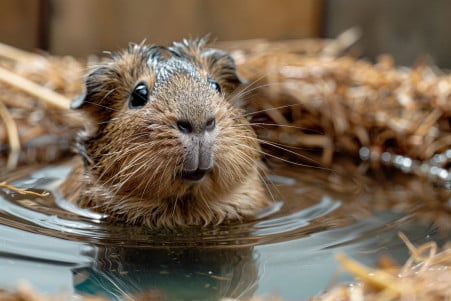Do Hedgehogs Swim? The Truth About Their Swimming Skills
2 March 2024 • Updated 1 March 2024

Hedgehogs are known for their cute and prickly appearance, but can they also move with ease through the water? Hedgehogs can indeed swim. Their quills are hollow, which helps them float and move in the water. Hedgehogs swim to find food or other resources, and they need to have a way to get out of bodies of water, like ponds and pools, to avoid drowning.
This article will take a deep dive into hedgehogs’ swimming skills by looking at research in the field of zoology and reports of hedgehogs in the wild. It will also consider hedgehogs’ biological adaptations, including their quills and their ability to swim, as well as the environmental conditions that impact their relationship with water in their natural habitats. Together, these perspectives will offer a well-rounded understanding of when and how hedgehogs swim.
Do hedgehogs swim?
How Hedgehogs Swim
The physics of hedgehog swimming are pretty interesting. The hedgehog’s quills, which are made buoyant by air pockets, help the animal float. In addition to buoyancy, hedgehogs use their legs to paddle in a doggy-paddle style to move through the water. According to BBC Earth, hedgehogs are strong swimmers and can swim up to 2 km in a single night, often to find food or just to explore.
When we look at hedgehogs swimming, we can see a combination of instinct and learned behavior. While most hedgehogs have the ability to swim, their willingness and ability to do so can depend on a number of factors, including their weight and breed, according to Hedgehog World. In the wild, hedgehogs may swim out of necessity to escape predators or travel through their natural environment to find food.
In the wild, hedgehogs are often found in areas with lots of underbrush and well-drained soil, according to Sciencing. These areas may also contain water, such as ponds and streams, that hedgehogs may encounter during their nightly activities. Hedgehogs are likely to swim because of these environmental factors and their need to find food or escape from other environmental pressures.
Hedgehogs’ Water Skills
Hedgehogs have a number of physical adaptations that make their swimming possible. In addition to their most well-known characteristic, their quills, which not only protect them from predators but also help them float, the hollow, air-filled spines of hedgehogs make them buoyant, according to ThePetFaq. Hedgehogs also have a layer of fat under their skin that helps them float and insulates them from the cold water.
These adaptations may have been selected for during the course of hedgehogs’ evolution due to the advantages they provide for survival. The ability to cross bodies of water would have allowed hedgehogs to access new areas and food sources, an important ability for an opportunistic feeder. In addition, the ability to float and swim is an important survival skill that can help hedgehogs escape from predators.
While hedgehogs are not considered to be true semi-aquatic mammals, their adaptations are similar to those of other semi-aquatic mammals, such as the star-nosed mole and water shrew. In a study by Kenneth C. Catania, he explains how these animals have evolved special adaptations to help them navigate and sense their underwater environment.
This knowledge has practical applications beyond academic interest, including helping to create water features that hedgehogs can use. Making sure that backyard ponds and pools are safe for hedgehogs can help with their conservation.
How the Environment Impacts Hedgehog Swimming
Hedgehogs live in a wide variety of habitats, from forests and grasslands to urban gardens and parks. As a result, many of these habitats, as Hedgehog Street explains, include the key elements that hedgehogs need to survive, including water, which can be found in the form of ponds, streams, and wetlands. The presence and accessibility of these water sources will determine how much hedgehogs swim, and how much they can swim.
The seasons also have a big impact on how hedgehogs interact with water. For example, when it rains, temporary pools form and watercourses fill up, which can lead to hedgehogs swimming more and swimming in different places.
On the other hand, when it’s dry, water sources can dry up, which can limit hedgehog swimming and change where they swim. These changes aren’t just a hassle, they are an important part of the natural world and the way that hedgehogs live in it.
Swimming can be important for hedgehogs, especially when they need to escape from predators or find new places to forage. While hedgehogs are immune to many predators, as Wikipedia points out, this doesn’t mean that they are immune to everything in the wild, so swimming can be an important way for them to escape from danger.
In urban areas, the water sources that hedgehogs encounter can either help them or hurt them, so it’s important for people to understand how hedgehogs use water so that they can help them survive and thrive.
Safety Concerns for Swimming Hedgehogs
Although hedgehogs are good swimmers, they can still be at risk of drowning and exhaustion, especially in man-made bodies of water. Cambridge Hedgehogs notes that ponds should have shallow edges or escape routes to help hedgehogs get out of the water. Meanwhile, covering pools and adding a ramp for hedgehogs can help prevent them from getting stuck and drowning.
It’s important to watch hedgehogs while they’re swimming since they can get tired and have trouble keeping themselves afloat. HedgehogFact.com explains that signs of stress include curling into a ball and losing quills, so it’s important to keep an eye on them and let them get used to the water at their own pace.
Meanwhile, Pet Keen recommends that pet hedgehogs have a natural slope in their tubs to help them get in and out of the water safely.
To make sure that water features are safe for hedgehogs, make sure that ponds have rocks, pots, or wildlife ladders to help hedgehogs get out of the water and avoid using chemicals. By doing this, we can make sure that we’re creating an environment that allows hedgehogs to explore their curiosity and natural swimming abilities while keeping them safe.
The Healing Paddle: Hydrotherapy for Hedgehogs
While swimming is a necessary life skill for hedgehogs, it can also be a source of physical and mental wellness, especially for those in captivity. Many professionals recommend that pet owners include swimming as part of their hedgehog’s exercise routine to help prevent obesity and keep them from getting bored. Swimming is a low-impact exercise that can help maintain muscle mass and heart health.
Hydrotherapy has also proven to be a valuable form of rehabilitation for injured and disabled hedgehogs. For example, the Little Silver Hedgehog blog shares the story of Honey, a hedgehog with an abnormal gait that was greatly improved by regular hydrotherapy sessions in a warm bath. Meanwhile, The Irish News tells the story of Phelps, a baby hedgehog that was able to walk again after a week of hydrotherapy.
These examples show how swimming can improve the lives of captive hedgehogs. However, it’s important to note that swimming should be supervised to avoid overexertion and ensure the hedgehog’s safety. If these precautions are taken, swimming can be a positive addition to a hedgehog’s wellness routine.
Hedgehogs and Their Surprising Swimming Skills
Hedgehogs’ ability to swim is made possible by their quills, which trap air and help them float, and their strong legs. Yet, while hedgehogs’ swimming skills go beyond the basic ability to stay afloat and also include foraging and exploratory behaviors, it’s important to make sure water is available to them in the wild and in captivity in a way that doesn’t pose a risk, despite their ability to swim.
The physical and psychological advantages of swimming for hedgehogs, especially those in captivity, are real and important. Making sure that hedgehogs have access to safe swimming opportunities can have a big impact on their overall health and well-being. For example, hydrotherapy, which is used in rehabilitation, can be a very effective treatment for hedgehogs that are recovering from injuries.
In the end, imagine a hedgehog swimming across a pond, a perfect example of nature’s adaptability. Hedgehogs’ aquatic abilities add to our knowledge of these popular animals and show us that there are still many things to learn about the natural world, even in its tiniest nooks and crannies.


